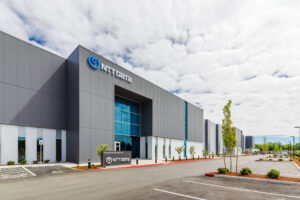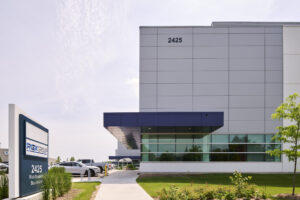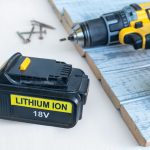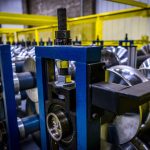
The construction industry has long been driven by the principle that “time is money.” A shorter project timeline means quicker revenue generation, and nothing demonstrates this concept more than how fast building can go from the ground up to operational. This is especially true for industries where rapid development directly correlates to financial success, such as data centers, manufacturing plants, and warehouses. In these fast-paced sectors, the difference of a few weeks can mean millions in lost revenue or opportunity.
Insulated metal panels (IMPs) are a strong alternative to traditional building materials such as concrete when accelerating project timelines without sacrificing quality or performance. These high-performance panels speed up the construction process and help contractors avoid costly delays and inefficiencies.
The need for speed
For many sectors, such as data centers, manufacturing plants, and warehouses, the faster a building is completed, the sooner it can generate revenue. Take data centers, for instance. These facilities have become a key part of the global economy, supporting digital infrastructure, cloud services, and vast amounts of data. According to Motley Fool, a financial and investing advice company, IBM’s data center revenue in the last quarter of 2024 was $4.26 billion. For some building operators and owners, once operational, large data centers could earn between $1 million per week to $1 million per day. The longer it takes to build and begin operations in these facilities, the longer it takes to start generating substantial returns. As the industry grows and demands accelerate, these projects must be completed quickly to stay competitive.
Lead times: IMPs vs. concrete
One of the most significant time advantages of IMPs is their reduced lead times compared to concrete. Precast concrete lead times can range anywhere from six to 12 months, depending on regional demand and production schedules. In high-demand markets—major metropolitan areas or booming industrial sectors—these delays can hold up entire projects, leaving contractors scrambling to make up for lost time.
Tilt-up concrete is subject to delays due to unpredictable weather conditions and the need for additional on-site labor and tradespeople to complete the job. On the other hand, IMPs offer a much faster turnaround. Lead times, including shop drawings and manufacturing, can be as low as three months. This significantly reduces the time spent waiting for materials, allowing projects to move forward faster and with greater predictability.
Schedule impact: IMPs cut weeks off project timelines
How fast a building can be constructed often depends on how quickly the exterior envelope—walls, insulation, and roofing—can be completed. One notable example of IMPs saving time involves a data center project. According to one business owner, the switch from concrete to IMP walls resulted in an impressive six-week reduction in the construction schedule. In another case, a data center project saved 30 percent on its timeline. These time savings allowed contractors to meet aggressive deadlines and start operations ahead of schedule.

Sequencing: IMPs accelerate the entire construction process
Traditional concrete construction often results in slower sequencing due to the number of stages required before the building is sealed. For instance, with concrete walls, the foundation must be completed first, followed by the installation of the walls. Afterward, additional work such as exterior painting, steel studs, insulation, sheetrock, and interior painting must be completed before the walls are fully finished.
IMPs are different. They arrive pre-insulated, pre-painted, and ready to install, eliminating several steps in the wall assembly process. The building is sealed once the panels are erected, and interior work can commence immediately. There is no need for additional insulation or interior finishes, which are typically required with
uninsulated concrete wall systems.
In addition, the sequencing benefits extend to the roof structure. In concrete buildings, where the walls provide the structure, the roof cannot go up until the walls are fully installed, creating a bottleneck in the construction process. With IMPs, roofing can proceed as soon as the structural steel is in place, enabling faster vertical and horizontal buildout.
Additional benefits of IMPs
IMPs offer additional benefits that justify their use in fast-paced, high-demand sectors:
Lower embodied carbon: IMPs from one leading U.S. manufacturer have been demonstrated to be 28 percent lower in embodied carbon compared to conventional concrete wall assemblies. This is crucial as industries strive to meet carbon reduction goals and contribute to green building certifications like LEED.
Weather-tight warranties: Unlike concrete, IMPs can provide comprehensive weather-tight warranties, ensuring buildings remain energy-efficient and free from water intrusion for years. Concrete walls can require frequent maintenance.
Paint warranties: Unlike concrete, IMPs also provide paint warranties. Throughout 20 years in a building, concrete walls could need repainting two to three times.
Cost-effective freight: The freight costs of transporting heavy precast concrete panels can be astronomical. IMPs, being lightweight, offer a more cost-effective shipping option, reducing overall
project costs.
Conclusion
The construction industry continues to face the pressures of tight deadlines, high demands, and ever-rising costs. From data centers to warehouses and manufacturing plants, the speed and efficiency offered by IMPs make them an essential tool for contractors and project managers looking to keep projects on track and within budget.
IMPs can make the difference between hitting deadlines and costly delays. The faster a building is completed, the
sooner it can contribute to the bottom line. Time is money; with IMPs, that time can be saved, and revenue can start flowing sooner.
Karim Muri is vice president of marketing services and strategy development for Kingspan Insulated Panels North America. For nearly 20 years, Muri has led strategic marketing in the construction products market. His global experience includes leadership roles in Australia and the United States, working in residential and commercial building sectors.





